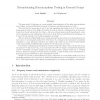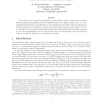688 search results - page 24 / 138 » General Partitioning on Random Graphs |
STOC
2004
ACM
14 years 7 months ago
2004
ACM
The main result of this paper is a near-optimal derandomization of the affine homomorphism test of Blum, Luby and Rubinfeld (Journal of Computer and System Sciences, 1993). We sho...
COMBINATORICS
2007
13 years 7 months ago
2007
The idea of graph compositions, which was introduced by A. Knopfmacher and M. E. Mays, generalizes both ordinary compositions of positive integers and partitions of finite sets. ...
APPROX
2009
Springer
14 years 2 months ago
2009
Springer
The r-parity tensor of a graph is a generalization of the adjacency matrix, where the tensor’s entries denote the parity of the number of edges in subgraphs induced by r distinc...
CPC
2006
13 years 7 months ago
2006
Abstract. We show that a maximum cut of a random graph below the giantcomponent threshold can be found in linear space and linear expected time by a simple algorithm. In fact, the ...
SIGECOM
2006
ACM
14 years 1 months ago
2006
ACM
Braess’s Paradox is the counterintuitive but well-known fact that removing edges from a network with “selfish routing” can decrease the latency incurred by traffic in an eq...


